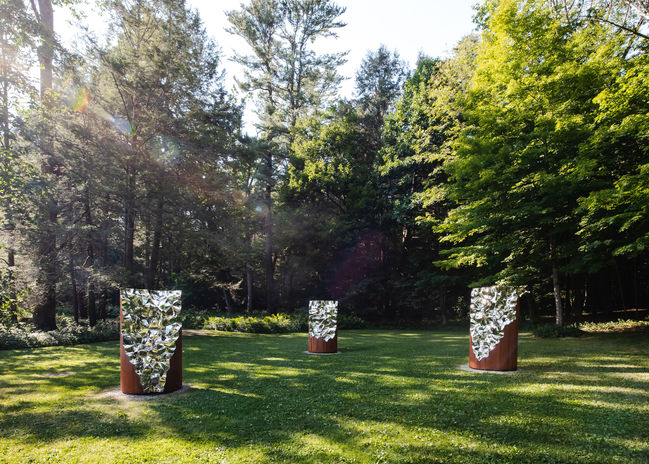When one thinks of large-scale abstract sculpture these days, what comes to mind is the work of Richard Serra, Robert Smithson’s Spiral Jetty, the tons of steel "dinosaurs” parked in sculpture parks such as Storm King or in front of corporate buildings and shopping centers. Given the labor, material costs, the space required to fabricate, store, and maintain such works, such sculpture has been either domesticated or has become the domain of public art’s programs, which place significant restrictions on what an artist may do. Consequently, large scale abstract sculpture, which in the 1950s-70s, were meant to be an intervention into the banality of everyday life today, at best signals a corporation’s progressiveness — or at worst it is used to as an inoffensive enhancement of a building’s lobby or plaza. This pairing of public art and corporate branding epitomizes the taming and commodification of modernism’s aesthetic antagonism to the middle-brow, which has resulted in the look of high modernism becoming a corporate genre. With the advent of post-Modernism’s preference for narrative and its significant bias against the abstract and the experiential, sculpture as a realm of serious investigation of scale, monumentalism, and structure seems to have, for the most part been abandoned. Likewise, gone are the adventurous benefactors who made the work of such artists as Christo, Claes Oldenburg, Robert Smithson, Richard Serra, Walter de Maria, Ant-Farm, S.I.T.E., James Turrell, etc., possible.
What set me to thinking about the state of large-scale sculpture is that I was invited to go on a press junket to Chesterwood in the Berkshires to see their 44th annual contemporary sculpture show, which this year was an installation of outdoor sculptures by Jonathan Prince. Chesterwood is one of the earliest venues in the United States to showcase large-scale works in an outdoor setting. Since 1978, Chesterwood has exhibited sculpture by more than 600 emerging and established artists on the site of the former summer home, studio, and gardens of the sculptor Daniel Chester French (1850 – 1931) who is best known for the seated figure of Abraham Lincoln (1911 – 22) housed in the Lincoln Memorial in Washington, D.C. Spending the day with a mini-van of critics promised to be an interesting summer day in the country. The pleasant surprise is that Prince’s installation "Elemental Matters" on view from July 1 - October 24, 2022, consisting of 12 large scale (rather than monumental) works sited throughout the landscape, and a visit with the artist at his studio set me to thinking about the state of sculpture in general.
Mainly a self-taught artist, Prince seriously began working in sculpture about 20 years ago, as he entered onto a new life path. In his youth Prince would, on occasion, intern in the studio of Jacques Lipschitz, where he learned his basic skills. Yet, his attitude toward sculpture is more significantly informed by his former endeavors as a surgeon specializing in the reconstruction of the palate, in film production, and as the founding several technology companies. Prince also holds patents for optics and worked with NASA on the Hologlobe Project for the Smithsonian. Subsequently, he formally mixes the industrial principles of the Neo-Concrete, the industrial aesthetic of Minimalism, and the phenomenology of Post-Minimalism with the scale of a 19th century public sculpture. While he does not shy away from the exploration of hi-tech materials and technologies, Prince retains a pride in the craft of his works’ making. The irony is that while hundreds of hours may go into forging and polishing the stainless steel used in the pieces that make up the exhibition "Elemental Matters" — given their precision the fact that these sculptures are the product of human labor and skill is not apparent.
Aesthetically he has schooled himself by looking at the work of such early modernist sculptors as Isamu Noguchi, and Jean Arp. However, the artists he most associates his work with are the late modernists such as Donald Judd, Richard Serra, Sol LeWitt, Michael Heizer as well as such contemporary artists as Jeff Koons, and Anish Kapoor. What he takes from the minimalist and post-minimalist is a concern for form, variation, and process, while post-modernism feeds his interest in fracture, non-linearity, craft, technology, surface and precision, not as subjects to be elaborated or confronted, but instead to be aesthetically presented. In this sense his work is indexical.
Scattered about his showroom/studio are diverse works in differing sizes and scales, which in the Constructivist /Bauhaus tradition, represent the fusing of art, design, and industry. When speaking of his works, Prince tends to focus on their technical and commercial aspects. For instance, where they have been placed or the number of man-hours of labor that have gone into their making, rather than on their aesthetic, or conceptual core values. As to these, his aesthetic is reductive though not essentialist and his approach to form and materials are modernist. In the broad sense of the term, Prince is a post-modernist in that his thinking is associative and what he seeks from the contrast of craft, industrial processes, and geometric forms is the poetic and contemplative.
Prince’s stated goal is for his sculptures to represent not only opposing forces, but also the breaks, tears, and fractures, which for him are a metaphor for life. He does not do this in a raw or expressionist manner, in that his approach to scale is non-monumental and their materiality is refined. Consequently, his works neither dwarfs the viewer nor are they confrontational. Instead, they tend toward the accessible and illustrative. Having recently read the French theorist Jacques Ranciere on the role that aesthetics sensibility plays in social programming. I find myself asking myself what Prince’s works might actually be an expression of in our present age of cultural transition.






